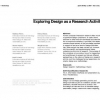ACMDIS
2006
ACM
14 years 6 months ago
2006
ACM
Randomness is being harnessed in the design of some interactive systems. This is observed in random blogs, random web searching, and in particular Apple's iPod Shuffle. Yet t...
ACMDIS
2006
ACM
14 years 6 months ago
2006
ACM
ACMDIS
2006
ACM
14 years 9 months ago
2006
ACM
Human-computer interaction research often includes a significant design component. In cases where software or other tools are developed and described, but no empirical evaluation ...
ACMDIS
2006
ACM
14 years 9 months ago
2006
ACM
Human-Computer Interaction (HCI) is defined by the Association for Computing Machinery (ACM) Special Interest Group on Computer-Human Interaction (SIGCHI) as “a discipline conce...
ACMDIS
2006
ACM
14 years 9 months ago
2006
ACM
ACMDIS
2006
ACM
14 years 9 months ago
2006
ACM
Reusing HCI design knowledge shows potential in allowing practitioners to design based on previously identified concerns. A reuse approach is presented that is based on claims, de...
ACMDIS
2006
ACM
14 years 9 months ago
2006
ACM
Storyboarding is a common technique in HCI and design for demonstrating system interfaces and contexts of use. Despite its recognized benefits, novice designers still encounter ch...
ACMDIS
2006
ACM
14 years 9 months ago
2006
ACM
Human-Computer Interaction (HCI) often focuses on how designers can develop systems that convey a single, specific, clear interpretation of what they are for and how they should b...
ACMDIS
2006
ACM
14 years 9 months ago
2006
ACM
Recent research suggests design pre-patterns, structured collections of evidence-based research and design knowledge, provide a useful resource for design activities in emerging a...
ACMDIS
2006
ACM
14 years 9 months ago
2006
ACM
Gibson’s seminal concept of affordance could have real design power if it could be adequately explained as a phenomenon that happens within the scale of human lifetime. Today th...



